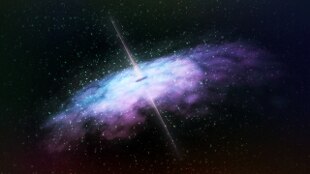Share
November 28, 2019 An impossible black hole, with a mass 70 times greater than that of the Sun, was discovered in the Milky Way at 15,000 light years from Earth, contrary to any prediction.The result, published in Nature, is due to the international research coordinated by the group of the Chinese Academy of Sciences led by Jifeng Liu, of the Beijing Observatory, and to which Italy participated with Mario Lattanzi of INNAF. The mass of this cosmic monster, accompanied by a star, is 4 or 5 times greater than that considered the limit for a black hole of this type. So far, in fact, it was believed that there were about 100 million black holes in the Milky Way, most of them with a mass no greater than 15 times that of the Sun.
"I don't know if it is the largest ever found, but the extraordinary thing is that, according to current theories of stellar evolution, such massive stellar black holes should not even exist, at least not in our galaxy", Lattanzi observes from Shanghai, where he is in these days working with colleagues with whom he signed the article. The black hole "we called it LB-1, from the name of our group," explains Liu. "Now - he adds - the ball goes back to the theorists, who will have to explain how its formation could have taken place in an environment with a metallicity similar to that of the Sun".
The black hole LB-1 is out of scale not only for its dimensions: its orbit is also anomalous because the star that accompanies it takes 79 days for a complete rotation; the silence is also anomalous as it is the only black hole discovered so far not to emit X-rays. This last feature made it really difficult to detect it and the solution was to use a 4-meter optical telescope, called Lamost, which is located in China , not far from Beijing and specialized in hunting for stars that revolve around invisible bodies. The variations in their light spectrum are the indications of the presence of a possible black hole. This is what happened when observing a star with a mass 8 times greater than that of the Sun, which revolved around an oversized black hole. The measurements were confirmed by comparing the data from other telescopes and now everything is ready to hunt down other black holes in the galaxy.

